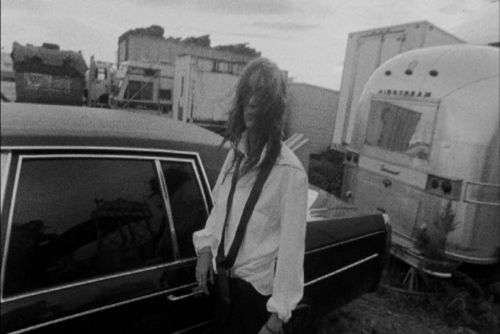 A woman quietly at the center of her times
A woman quietly at the center of her timesThin, long-faced, androgynous, stringy-haired, dressed in skinny pants, coat, dangling tie, she is unmistakable, made famous by her own achievements as poet, painter, singer, musician, and activist and her close friend the late Robert Maplethorpe's iconic photo-portraits. Her music is and was a distinctive fusion of punk rock and spoken poetry. This film, created with an art installation and photography book, is the product of her 12-year collaboration with director Steven Sebring, and it is dominated by her own voice and vision, her sense of poetry, her wry warmth, elegance, and taste. She's a sweet, kind person, as we see her, who's suffered and been redeemed by significant personal loss. She particularly describes how the unexpected death of her younger brother has given her a larger, warmer heart, because it has been filled with him. The value of Smith's kinship with Blake and Rimbaud sinks in as she depicts herself in an ongoing cloud of quiet words. This is a public figure who emerges as a deeply authentic private person.
The film, mostly in evocative and beautiful but not arty black and white, cunningly but not logically edited, is meandering, equally strong in its depiction of personal talismanic objects and treasured people, but despite beginning with Smith's recitation of a series of personal milestones and dates, it's deliberately vague about denoting times and places--reminding one of the famous passage from Henry Green's
Pack My Bag about the value of not naming names that goes:
Prose should be a long intimacy between strangers with no direct appeal to what both may have known. It should slowly appeal to feelings unexpressed, it should in the end draw tears out of the stone. Smith and Sebring seem to know that to speak to us as poetry, her life need not be hung on a list of names and dates.
Dream of Life then is a film appealing to the open-minded and indulgent, unlikely to win over outsiders or skeptics. Despite its many beauties, it's rather a pity it can't serve as a more informative introduction to the woman and her work. Since she believes in reserve, but also in ruthless candor, Smith reveals that she has always had to get other people to tune her guitar. Sam Shepherd, whom she first met as a drummer, finds her playing ragged when they play a rather superfluous impromptu duet. She seems important as a poetic voice, not a musician or singer. This film, singing its own song, not cajoling, is full of the palimpsest pleasures of a layered life and likely to reward repeated viewings.
Patti Smith seems most convincing to this respectful non-devotee as a figure, an "icon," who was central to her times, friend of William Burroughs and Allan Ginzberg and Gregory Corso as well as Maplethorpe, a cult figure who has toured with Bob Dylan, a bereaved wife and mother who has taken long sabbaticals from her public career to immerse herself in living, a woman with dear siblings and sweet parents from a happy childhood. A woman whose son and daughter are hard to tell apart from her, who pays tender homage onscreen to the tombs of Blake and Rimbeau with caressing hands on the marble and use of her ever-present Polaroid camera. From seemingly humble south Jersey origins, she grew up loving books and worshiping at the font of poets like Shelley and Whitman.
After her remarkable relationship with Maplethorpe she went to live in Michigan with her husband Fred "Sonic" Smith, then when he died returned to poetry and music and activism in New York in 1994. As Andrew O'Hehir points out in his Salon review, she "is perhaps the only major surviving link from the beat era to the '70s Manhattan art scene to the birth of punk to the present." She has evidently done this through her own special calm and integrity and keen instinct.
Now 61, living in the Chelsea Hotel, still vibrant and active and herself, she is most impressive in a passionate, deeply angry reading of the American Declaration of Independence, which merges into a ferocious indictment of George W. Bush, the most succinct yet complete and powerful one I have ever heard. A truly amazing and astonishingly winning lady. Her influences has been enormous, and her words are often wise. “In art and dream may you proceed with abandon. In life may you proceed with balance and stealth.” Famously, from her first album, the opening words: "Jesus died for somebody's sins, but not mine. . .My sins my own/They belong to me...."
[Debuted theatrically at Film Forum in New York; seen at an evening screening at Cinema Village. Gradual limited US release coming.]





